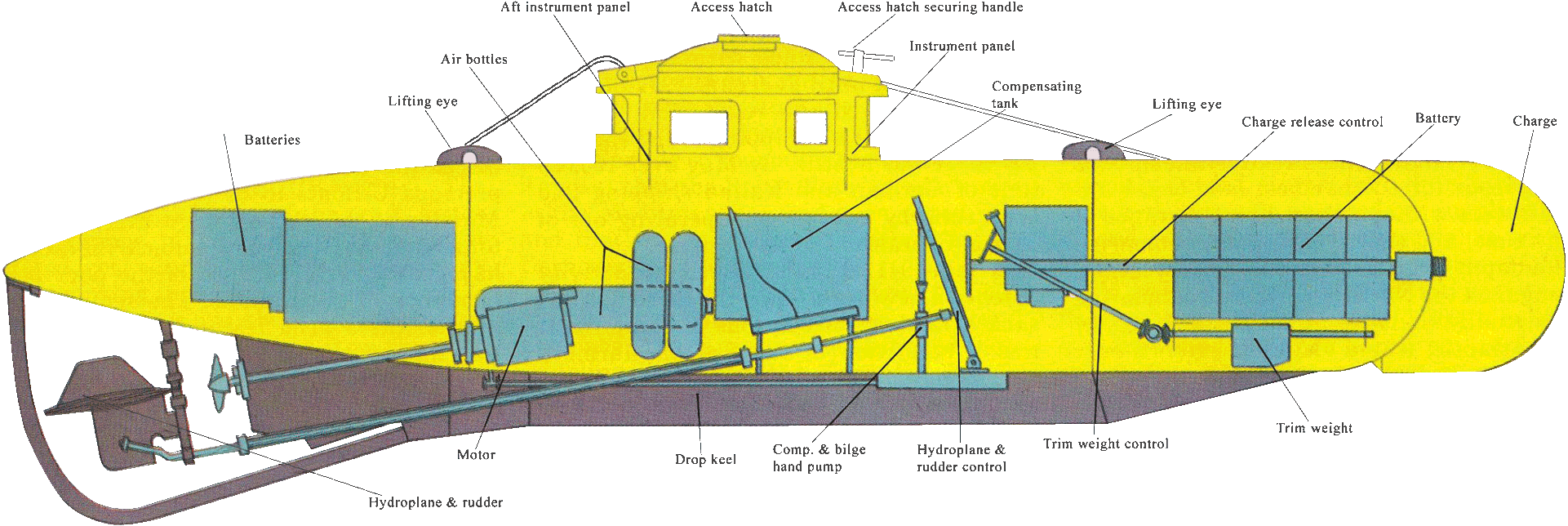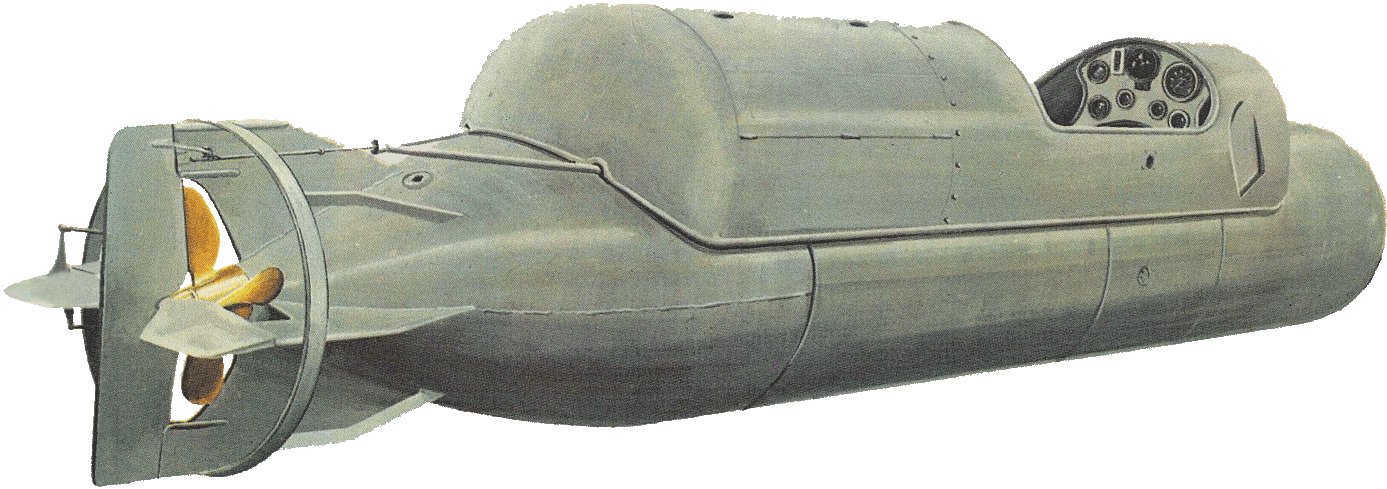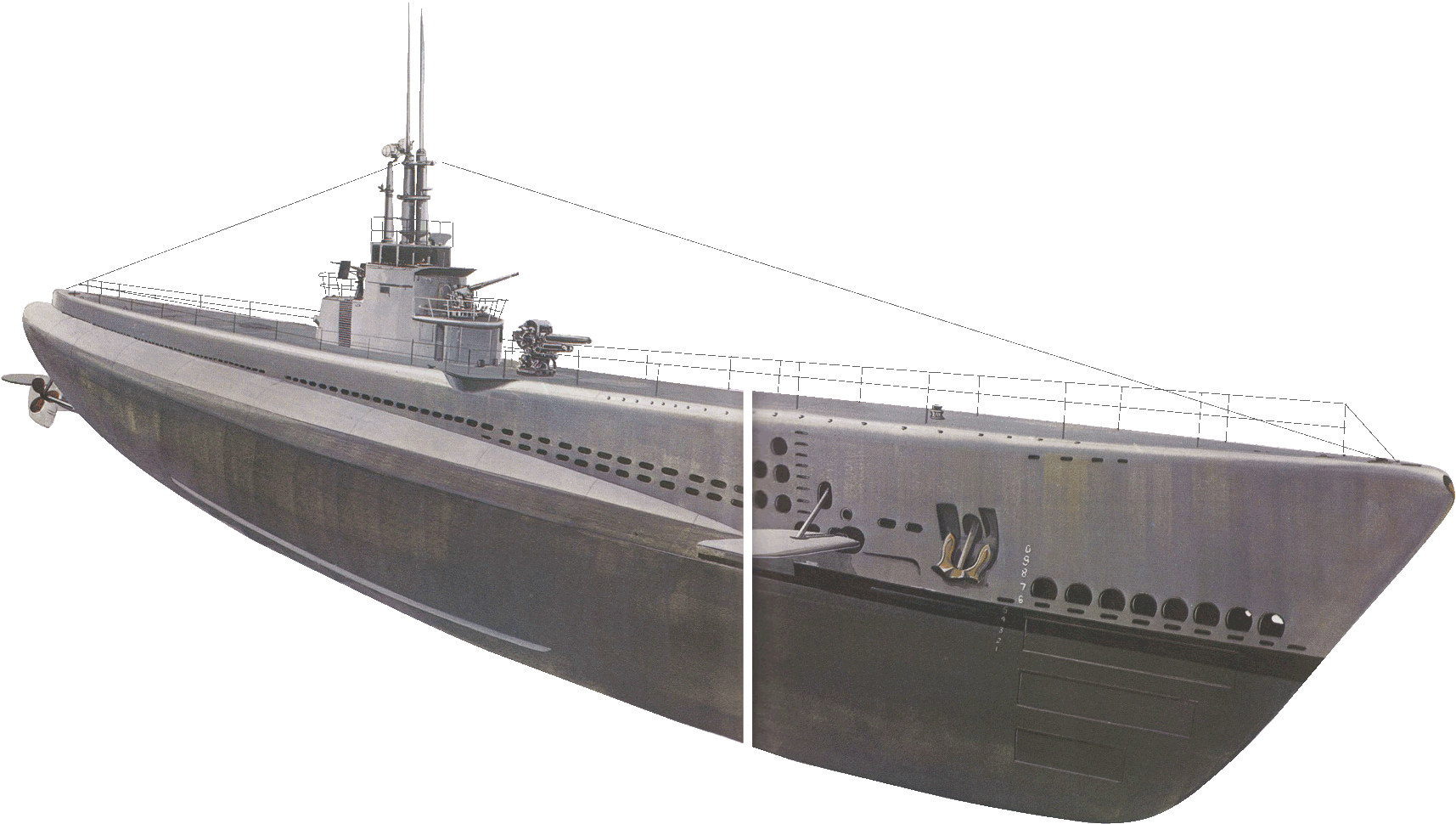
ANTONY PRESTON, JOHN BATCHELOR
THE SUBMARINE SINCE 1919
British "Chariot" Human Torpedo. Copied from the Italian Pigs which attacked Alexandria in 1941, the Chariot was not a torpedo but a two-man midget with a warhead which could be detached and either left under an enemy ship or clamped to her bilge-keel. Because the operators were exposed, the Chariot proved most useful in the warmer waters of the Mediterranean
Although the last in the field, the British made the most impressive use of midget submarines. They copied the Italian "pigs", calling them "Chariots", and then designed a range of battery-driven midgets to penetrate the Norwegian anchorages which were sheltering German heavy units. In 1941/42 ships like the Bismarck and Tirpitz were beyond the range of heavy bombers, and there was no other way to penetrate a Norwegian fiord.
One of the leading advocates of midget submarines was Commander Varley, who had served in submarines in the First World War. His firm built the prototype X3, while Portsmouth Dockyard built X4. Six production models were begun in December 1942, and by September 1943 they and their hand-picked crews were ready to attack the battleship Tirpitz in Altenfiord. Unlike the Italian and Japanese midgets, these "X-craft" did not have torpedoes, but carried side-charges, containing a half ton of explosive each, which were dropped underneath the target. Although fitted with a diesel engine as well as an electric motor, they were too small to undertake long passages and were always towed to their target area by full-sized submarines.

British X-Craft. These four-man midgets were designed to attack warships such as the Tirpitz in heavily defended anchorages. They had a "Wet and Dry" compartment to allow a diver to leave and re-enter. Their greatest exploit was the successful attack on the Tirpitz in Altenfiord in September 1943. Displacement: 27 tons (surfaced). Armament: Two 2-ton side charges (released beneath the target). Speed: 6,5 knots (surfaced), 5,5 knots (submerged)
The attack on the Tirpitz on 22 September 1943 was a great success, for although the charges did not sink hers they inflicted such damage on her that she was eventually moved south for repairs. Here she was at last within range of bombers, and she was: finally eliminated little more than a year later. All six of the X-craft were lost, including one which broke down on the way out, and the surviving one, X10, which was scuttled afterwards, A slightly enlarged version, the XE-craft, was built for the Far East. They had more stowage space and had the blessing of air-conditioning to reduce the strain on the four- or five-man crew. There was also an air-lock to allow a diver to leave the midget and place limpet mines on the target's hull, and spring-loaded legs to make it easier for the midget to rest on the bottom.
Before the Normandy invasion in June 1944 midgets were used to reconnoiter landing beaches, and to provide information on tides and obstructions. On D-Day itself several acted as navigation beacons well inshore to guide the first assault wave. In the Far East they revived Simon Lake's ideas of fifty years earlier by sending out divers to cut submarine cables. Chariots were used in Norway, but the water proved far too cold for the crews, and they proved better suited to the Mediterranean where they sank the Italian cruisers Gorizia, Bolzano and Ulpio Traiano.

British "Welman" Type Midget. A one-man craft capable of fixing a 560-lb charge to its target by magnetic clips. It is not known how many Welmans were produced, but they proved unreliable
SUBMARINES IN THE MEDITERRANEAN
The submarine war that the British had feared in the Mediterranean when Italy entered the war in June 1940 did not take the form expected. This was partly due to the inertia of the Italian Navy whose few energetic submariners were shortly to be sent to Bordeaux, but particularly because Admiral Dönitz was so reluctant to the U-Boat offensive in the Atlantic by sending boats to the Mediterranean. For the British submarines, however, there were tempting targets in the form of Italian shipping taking supplies to the Italian and German troops fighting in North Africa. On the other hand the Mediterranean was dangerous for submarines: land-based aircraft were within a short flying distance at any time, and they could spot a submarine at a depth of up to 50 feet in calm weather, as against the North Sea, where a submarine is virtually invisible at periscope depth, or the Atlantic, where visibility extends only 30 feet down in ideal conditions.
Reverses to British fortunes, both on land and at sea, made it very hard to exploit the weakness of the Italians. The Luftwaffe had reinforced the Regia Aeronautica, which gave the Axis Powers as air superiority over large areas of the Mediterranean and thus made the British submarines' job very difficult. Losses were heavy among the large submarines of the "O", "P" and "R" Classes, not least because of their leaky external fuel tanks.
Nevertheless, in the early months of 1941 there were many successes. It is odd to note that British submarines were still forbidden to sink merchant ships without warning, and it was not until February 1941 that the Cabinet removed the restriction, on assumption that all shipping; found south of 35' 40'' N was hostile. By May over 100,000 tons of German and Italian shipping had been sunk by submarines operating out of Malta, Gibraltar and Alexandria.
In mid-1941 British submarine activity reached a new peak, when the three flotillas sank a further 150,000 tons of shipping. It was a repetition of the Sea of Marmora campaign of 1915, with the gun being used as much as the torpedo, and coastal targets such as bridges and railway lines coming under attack. Quite apart from the loss of supplies to the Italians and the German
Africa Korps, which was described by the Germans as "unendurable", these widespread activities strained a naval organisation which had never been very strong. Had this situation continued the British were heading for an impressive victory over their enemies at relatively small cost, but just when they seemed unstoppable, disaster struck.
Once again, the submarine had taken a hand. At last the losses and demoralisation of Axis naval forces in the Mediterranean forced the Germans to allow some of their precious U-Boats to be transferred to the Mediterranean. When they arrived they found that the British anti-submarine tactics had grown rusty because of the poor performance of the Italians. The sequence of events was a grim lesson for the British, who had grown used to their freedom. The first important victim was the aircraft carrier Ark Royal, torpedoed in the Western Mediterranean by U81 and U205 on 13 November 1941. Next to go was the battleship Barham, torpedoed in the Eastern
Mediterranean by U331 on 25 November, and the light cruiser Galatea, sunk by U557 on 15 December.
The exploits of Italian submarines were hardly notable for their vigour, but in one area the Italian Navy showed not only ingenuity but great personal courage. During the First World War they had pioneered midget submarines as well as special assault craft for penetrating defended harbours. Profiting by this experience they developed the "Maiali" or "Pig", a torpedo-shaped small submersible craft which was controlled by two men wearing self-contained underwater breathing apparatus (SCUBA gear). The operators rode the body of the craft, hence its nick-name of "human torpedo", but it differed from a torpedo in that it was simply a slow-moving underwater vehicle to allow two frogmen to move about an anchorage. The "warhead" was detached from the nose of the "pig" and then attached to any convenient projection on the bottom of the target vessel, such as a bilge keel, by clamps.

Italian "Pig" Human Torpedo. The best known of all midgets, these "Maiale" (Pigs) immobilised two British battleships at Alexandria in 1941. The forward operator was the commander, who had to control the craft, while the diver was responsible for placing the explosive. Speed: 2·8 to 3 knots; Endurance: 5-6 hours at full speed; Max diving depth: 50 ft
The "pigs" could not travel far, so the submarines Scire and Gondar were converted to carry three each in watertight containers on deck. After an abortive attempt against ships in Gibraltar in September 1941 the Scire was sent to Alexandria .two months later. On the night of 18 December she put her three crews over the side; as luck would have it a British cruiser was entering the harbour and so the three "pigs" were able to slip through the net defenses without any difficulty. They found their targets, the battleships Queen Elizabeth and Valiant and an oiler, and duly placed their charges. Early the next morning the charges went off, causing heavy damage to the two battleships. Coming so soon after the other losses, it meant that the Royal Navy's heavy units in the Mediterranean had been wiped out, and that the Initiative had passed to the Germans and Italians.
Other events in the Far East were to add to the Royal Navy's problems. For on 7 December the Japanese had launched their crippling attack on the American Pacific Fleet at Pearl Harbour, and had followed this by sinking the British capital ships Prince of Wales and Repulse. Aircraft, war ships and shipping had to be switched to the Far East, stripping the Mediterranean to the bone. The only naval forces left to harass the Axis supply lines were submarines, but now they had to operate in the face of enemy air superiority. Their base at Malta was under constant air attack, and it became necessary to submerge and lie on the bottom of the harbour by day, surfacing to recharge batteries at night.
As early as May 1941 Malta's position had been precarious, and so the minelaying submarine HMS Rorqual was sent on an experimental supply run. She took three weeks to convert at Alexandria, and finally sailed on 5 June with over 100 tons of urgently-needed stores, including high-octane fuel, kerosene and medical supplies. A second trip on 25 June showed that with careful attention to stowage even more fuel could be carried, and later in the year the fleet submarine Clyde took 1,200 tons of supplies, at a time when hardly any surface ships could get through. More runs were made by the Osiris, Porpoise and Urge, and by the middle of 1942 submarines had taken 65,000 tons into Grand Harbour, a staggering feat which was only matched by the efforts of the Japanese in the Pacific.

British Vivid. The "V" Class was a development of the "U" Class, but could dive deeper by virtue of having welded hulls. As the collapse of Italy in 1943 eliminated the need for small submarines many of this class were transferred to other Allied navies. Displacement: 545 tons (surfaced). Armament: Four 21-in torpedo-tubes; 8 torpedoes carried; one 3-in AA gun; 3 machine-guns. Speed: 12¾ knots (surfaced), 9 knots (submerged)
SUBMARINES IN THE PACIFIC. THE ROLES REVERSED
The experience of American submarine-commanders in the Pacific was vastly different from that of their German counterparts in the Atlantic. The Japanese stubbornly refused to convoy their ships and the American submarines were able to play havoc with their shipping - so much so, that submarines began to sink more escorts than escorts could sink submarines
The destruction and immobilisation of the United States Navy's battleships at Pearl Harbour left it with only two ways of carrying the war to the Japanese: carrier-borne aircraft and submarines. By December 1941 the USN had 113 submarines, of which 04 were elderly boats built during the First World War and suitable only for training and coastal work, nine large cruiser-submarines which were not mechanically reliable, and 40 newer submarines. Fortunately Congress had authorised a further 73 boats of which some 30 were actually under construction.
Although the number of builders had dwindled to three as a result of the Depression, American industry had little trouble in expanding the output of diesel engines and electric motors, so when the Bureau of Ships asked for three additional yard, two commercial builders and one Navy Yard to undertake submarine building, they able to provide them.

American S25 (SS130) (side elevation)
At this point it opportune to insert a note; about the classificaition of US submarines. From 1911 all submarines were assigned class letters and hull numbers, and the old fish and reptile names were discarded. The "V" series were distinguished by the numbers V1-V9 as Fleet Submarines, but in 1920 the designations SS (Submarine), SF (Fleet Submarine), SC (Cruiser Submarine) and SM (Minelaying Submarine) were introduced as a temporary measure, with their own A, B, C and D pendant numbes. Thus the USS Cachalot, for example, was simultaneously known for a while as SS170, C1 and V8, but in 1910 this multiple system was swept away, and only SS-numbers were retained. The fish names were reintroduced in 1931 with the Barracuda (SS163) and continued until the first Polaris submarine was launched in 1959.
The Pacific was seen clearly as the area of any future conflict, so American designs emphasised high surface endurance, habitability and good torpedo capacity. After the unsatisfactory experiments with, cruiser-submarines in the 1920s, the "P" Group of 1933-1938 was developed through the "S" and "T" classes into the 1,500-ton "g" Class of 1940. In view of the limited number of yards available, standardisation of design was essential, and although three classes were built, they were so similar as to be virtually identical, the famous Gato and Balao Classes, and the later Tench Class. With an overall length of 311 ft 9 in and a beam of 27 ft 3 in, they had welded hulls and diesel-electric drive, i.e. diesel generators driving electric motors coupled to the shafts through reduction gears. This method had also been introduced in contemporary British submarines, and replaced the former dual diesel or electric drive in older submarines.

American S25 (SS130). The "S" Class was the last design produced for the USN in the First World War, and in 1941 a few units were stationed in the Far East. They proved to have too little endurance for the Pacific, and so they were withdrawn. S25 was lent to the Royal Navy for training, and then became the Polish Jastrzab. She was sunk in error by friendly ships in 1942
All wartime US submarines had the same double hull divided into eight watertight compartments, with six ballast tanks and four fuel tanks, though stronger hulls were introduced in the Balao and Tench Classes. The armament was heavy, six torpedo-tubes forward and four aft, with stowage for 14 reload torpedoes, and a deck gun. During the war the gun changed from one 3-in/50 cal to 4-in or 5-in and a heavy battery of 40-mm or 20-mm AA guns, and configuration of conning towers changed to accommodate them. But for all, their heavy armament and generally excellent design, US submarines began the war with serious disadvantage: like the German U-Boats they suffered from defective torpedoes. The magnetic pistol was to blame as well, and for the first two years many attacks on Japanese targets were useless It is strange that two countries with a high reputation for their engineering standards should have introduced a new weapon without spotting its weakness until long after it had entered service.
The Japanese, on the other hand, did not approach the submarine problem as systematically as the Americans. By 1940 there was a noticeable ladk of medium-sized boats to supplement the large cruiser-types which seemed to fascinate their admirals unduly. The 1940 Additional Programme tried to rectify this with an order for more than 80 of the K6 Type, 1,100-tonners armed with four torpedo-tubes. Although rather small they had a theoretical range of 11,000 miles at 12 knots, about equal to an early Gato, and were considered to be a very successful design. Production problems resulted in only 18 being completed, RO35-RO50 and RO55 and RO56, and all but one were sunk.

American Gato. The USS Gato was the lead ship of a class authorised in 1941, before the United States entered the war. Over 200 of this very good design were ordered by 1945, and they were the backbone of the US Navy's submarine onslaught on Japan. Displacement: 1,526 tons (surfaced). Armament: Ten 21-in torpedo-tubes (6 forward, 4 aft); 14 reloads; one 3-in gun. Speed: 20¼ knots (surfaced) 8¾ knots (submerged)
The same programme saw the commencement of 9 "medium" 600-tonners of the KS Type, a strange decision in view of the distances involved in the Pacific, but under the 1941 Emergency War Programme there was an immediate return to giant aircraft-carrying submarines with the 140 and 146 Classes. The 112 was a repeat of the 1937 A1 Type, a long-range cruising submarine intended to act as the headquarters for hunting groups of smaller submarines. The surface displacement was nearly 3,000 tons, and aircraft were carried, but most of the additional displacement was used to increase - to as much as 22,000 miles the 112.
These submarines were meant to play, their part in a grandiose plan to seek out and ambush American surface forces across the wide expanse of the Pacific, and they were supplemented by midgets to attack the enemy if he should refuse to leave his defended harbours. The aerial attack on Pearl Harbour was intended to be supported by a torpedo attack from some Type A midgets, and one of the minor mysteries of that debacle is how the Americans sighted and sank one of them at the entrance to Pearl Harbour before the main attack without alerting the defenses. The attack was not a success, nor was a similar attack on Sydney Harbour in 1912, but in the same year the British battleship Ramillies was badly damaged by a midget launched from a parent submarine off Madagascar.
The nation that introduced the Kamikaze concept had little difficulty in applying it to naval warfare, and in l943 the first of a range of suicide craft was developed, the Kairyu; it was a development of the Type A midget, but production did not start until early in 1945. A much better-known development was the Kaiten, basically a piloted version of the famous 24-in Type 93 "Long Lance" torpedo. The three later models of Kaiten used a high-speed hydrogen-peroxide engine, but suffered so many production problems that the Model 4 was fitted with a conventional torpedo motor and carried a much heavier warhead in compensation.
The main problem for the Japanese at the beginning of the war was not one of design, but the question of how they intended to use their submarines. From the start the long-cherished aim of a general fleet action was paramount in the Imperial Japanese
Navy's plans, and all submarine tactics had to be subordinated to that idea. Too much attention was paid to the need to maintain an offensive and aggressive outlook, which led to the grave error of assuming that warships were the only important targets for submarines. It also led to the equally serious error of neglecting the defense of merchant ships on the grounds that convoying was merely a defensive measure.
The lessons were painfully learned by the Japanese as American submarines proceeded to cut their lines of communication.
Losses of vital tonnage went up, so that it became harder and harder to reinforce the perimeter of island bases, which were essential to the Japanese maritime strategy. Worse, the homeland depended on imports for 20 per cent of the food consumed, 24 per cent of its coal, 88 per cent of all iron ore, and 90 per cent of its oil.
In the light of these statistics it is hard to understand why the Imperial Navy did not complete any escort vessels until 1940. Apart from a handful of old destroyers converted, the only further effort made by 1941 was the construction of another 22 escorts, and even they were given a low priority. The Japanese High Command did not expect the American submarines would be able to penetrate the defensive perimeter, and it was not until late in 1943 that any sort of convoy system was introduced. Even then, it was a very reluctant gesture and it was hampered by the desperate shortage of escorts. Over 4 million tons of shipping was sunk by American submarines, and by mines laid by submarines and aircraft, and when the war ended in August 1945 the Japanese mercantile marine comprised only 231 ships - in 1939 Lloyd's Register listed 2,337 ships!
The American submarines in the Pacific were supported by a small number of British and Dutch submarines, and after the collapse of Italy in 1943 the British were able to transfer reinforcements from the Mediterranean. By early 1944 there were three flotillas in the Far East, two at Trincomalee and a third at Fremantle in Australia, operating under American command. Because of their smaller size the British and Dutch boats were principally employed about the 10-fathom line west of Singapore where the big US submarines found it difficult to operate.
By comparison with the staggering losses inflicted by the American submarines, the tonnages sunk by the British and Dutch were modest, largely because the Japanese had withdrawn many of their units. But many small coasters and junks were destroyed by gunfire. HMS Tally Ho sank the cruiser Kuma off Penang, however, while Taurus sank the submarine 134 in the same locality. When the patrol was extended the losses went up, and HMS Trenchant's CO was awarded the US Legion of Merit for sinking the cruiser Ashigara. The midget submarines XE1 and XE3 disabled the cruiser Takao in Singapore, and two "Chariots" from HMS Trenchant attacked merchant shipping at Phuket in Thailand. Excluding minor vessels under 500 tons, British and Dutch submarines sank a total of 87,000 tons of shipping.
Japanese counter-measures were poor, and only 60 US submarines were sunk, with a much lower loss ratio than that suffered by the German U-Boats. When the war ended the Japanese authorities told the Americans that their anti-submarine forces had sunk 486 boats! American submarines were also able to sink eight aircraft carriers and 12 cruisers, the classic examples being the torpedoing of the 62,000-ton Shinano by the Archerfish, and an ambush by the Dace and Darter which sank two heavy cruisers and damaged a third. Such was the ascendancy of American submarines over the Japanese that they were able to tackle escorts with impunity. Their outstanding tactic was the "down the throat shot", a full salvo fired at short range at an escort bearing down on the submarine. It required very fine judgment and an iron nerve, but it meant that US submarines sometimes sank escorts faster than they could sink submarines.

American Drum (SS228). The Gato Class was the standard wartime design for the USN, and proved a superb weapon for the Pacific. As the war progressed the AA armament was increased, because American submarines operated on the surface for much of the time. The Drum is preserved at Mobile, Alabama. Displacement: 1,526 tons (surfaced). Armament: Ten 21-in torpedo tubes (6 forward, 4 aft); 24 torpedoes carried; one 3-in gun; two 5 and two 3 machine-guns. Speed: 20¼ knots (surfaced), 8¾ knots (submerged)

Japanese I368. The Type D1 was designed to carry supplies to isolated Japanese garrisons in the Pacific, and had a radius of action of 15,000 miles on the surface. The bow torpedo-tubes were removed after trials, and they relied solely on their guns for defense. One or two Daihatsu landing craft could be carried in wells on the deck casing
The German wolf pack system was introduced in the Pacific in 1943, but the Americans used groups of only three boats, with such exotic nicknames as "Laughlin's Loopers", "Ed's Eradicators" and "Ben's Busters". With the advantage of radar, which the Japanese escorts lacked, they were able to track their targets with ease and avoid any counter-attacks. Like the Germans, the Americans found that attacking on the surface at night was very profitable, but unlike the British the Japanese escorts could not stop submarines from racing ahead to a new attacking position, because of their lack of radar.
We have much more interesting information on this site.
Click MENU to check it out!
∎ cartalana.com© 2009-2025 ∎ mailto: cartalana@cartalana.com
